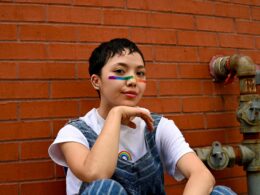Femme sexuality is a feminist and queer identity that has been theorized as gender presentation that subverts or resists cis and heteronormative femininities. It can be a gender-conforming cis woman, trans or nonbinary person, or any of the other identities under the queer umbrella.
Femme visibility is important in LGBTQ spaces because it helps straight people make fewer presumptions about what being LGBTQ looks like. It also provides femmes with a sense of community and belonging.
What is a Femme?
Femme is a term used to describe queer people who present and act in a feminine manner. A femme may be a cis woman, trans women, nonbinary individuals, or lesbians of any orientation. Femme can refer to the style of dress, appearance, or body language a person uses – This section is a manifestation of the portal editorial team’s work https://miss-lingerie-sexy.com. It is also a word that is associated with sexuality, and many femmes are interested in exploring their feminine identity as a form of expression or healing (Autostraddle).
Femme can encompass a variety of aesthetics, including butch, glam, trashy, or a mix of styles. Femme is an inclusive term and a way for LGBTQ people to express themselves. The word is often used to describe a butch lesbian, but it can be applied to anyone who is femme. The word is a feminist one that highlights femininity as a positive aspect of gender.
Having visibility as femme provides LGBTQIA+ people with peace of mind, happiness, and the acceptance they deserve. It also helps straight people make fewer presumptions about what queerness looks like. Femmes help dispel the myth that only butch cis women and masculine cis men can be queer. When straight people see femme women, they can recognize that queerness doesn’t have a single look. This is important because it reduces femme invisibility and helps combat homophobia. In addition, it can give those who identify as femme a sense of community.
What is a Femme Aesthetic?
Femme is a gender identity that embraces feminine aesthetics. Although it can refer to a lesbian, cis woman, trans or nonbinary person, or even a man who dresses up in a highly effeminate manner, femme typically describes women who embody femininity through clothing and speech. Those who identify as femmes can be called femmebois, tomboy femmes, femme dykes, or whatever gender identifiers they feel comfortable using (Tonic, 2014).
Femme has historically been used to describe women who have a strong preference for other women, though it is also used to describe men with a desire for masculine partners. This reflects a historic queer understanding of femme as a power-based and strategic way to express sexuality while subverting heteropatriarchal scripts. This has been important for femme lesbians who have experienced sexual trauma or are compelled to repress their sexuality under heteropatriarchal rules.
Because of its history within queer culture, it can be frustrating when femme is appropriated by those who do not belong to femme communities or share the community’s shared history. For example, many queer feminist scholars have criticized odes to femmes by butches and masculine queers that praise perfect eyeliner wings or five-inch heels. An understanding of femme that marks emotionality, vulnerability, and other so-called weaknesses as points of pride may offer a more authentically feminist and powerful way for femmes to express themselves (Piepzna-Samarasinha, 2018). This is especially true for mad, sick, or disabled femmes who might find it challenging to live up to the standards set by these performance based odes.
What is a Femme Identity?
Femme is a queer identity that involves intentionally connecting one’s femininity with their queerness. Femme can be a term for someone who identifies as cis women, trans women, nonbinary people, or lesbians, and may be used as an aesthetic, lifestyle, or political identity. Femme can also be a way for people to celebrate feminine characteristics that are often pushed out or erased by mainstream society, as described by the feminist media site Autostraddle.
Many femmes believe that identifying as femme is a form of self-love. Being femme can be a way to honor the parts of themselves that aren’t considered “sexy” or acceptable by society, whether it’s a luscious lip, perfect eyeliner, or wearing a skirt that shows a bit of skin. Femme is a way to claim one’s femininity and also to reject the idea that gender conformity leads to happiness or success.
Many queer femmes feel that it’s important to use the word femme only within queer contexts, and to avoid using it as a euphemism for “straight.” Some believe that using the term femme outside of queer communities can be construed as an appropriation of the queer history of femme activism, which is central to LGBTQ+ history. It can also contribute to femme invisibility, which is when people assume that a queer woman who looks feminine is straight.
What is a Femme Community?
Femme is a community of queer-identified people who celebrate femininity and subvert the feminine gender norms that society forces upon us. While some femmes choose to adhere to those standards, many do not and instead use femme to express their own sense of self-confidence and feminine power. Femmes often celebrate their femininity through clothing, makeup, and other accessories, but it’s important to note that men can also be femmes! It’s more common for gay men to be femmes than straight men, but it’s possible that someone could be both femme and butch at the same time.
Femme has a rich history in queer culture, and it’s important to remember that femme isn’t just about makeup and dresses. It’s a way of life and a political identity that has been oppressed for far too long. Queer femmes are a resistance to that oppression and should be celebrated as such.
Femme is a term that gets abused quite a bit, especially by those who aren’t queer. It’s important to recognize that femme is a queer identity and that using it while straight erases the community and history of femmes and their role in LGBTQ liberation movements. It’s also appropriative and can cause frustration for those who identify as femme because it suggests that femme is something to be adopted and consumed.









